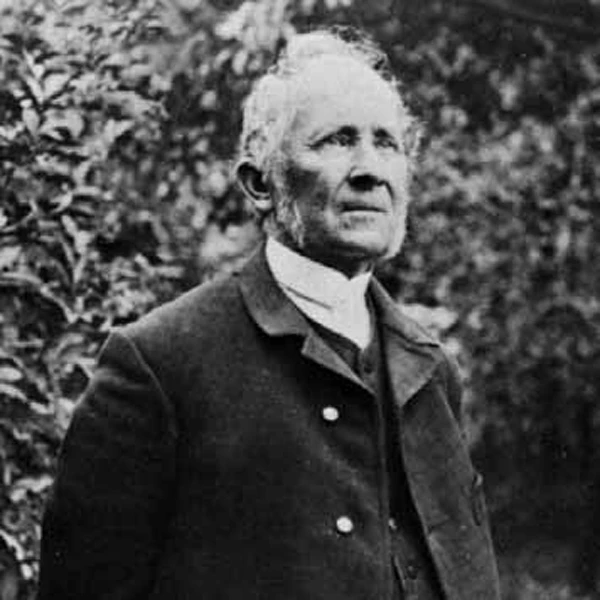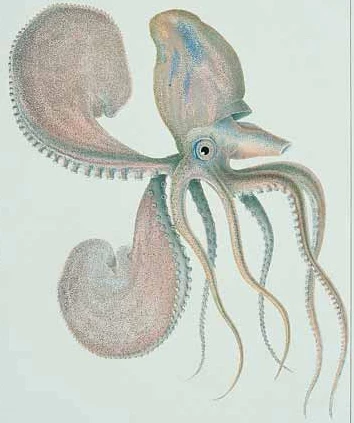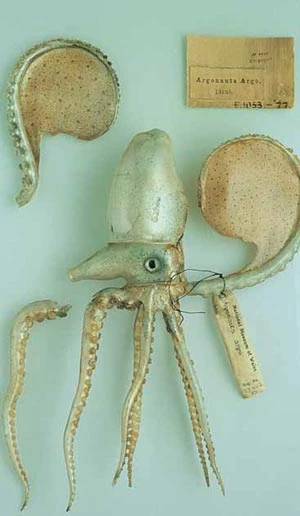Repairing the irreplaceable - Conserving the Blaschka glass models
Leopold Blaschka, about 1895. Image courtesy of The Botanical Museum, Harvard University, Cambridge, MA.
Rudolf Blaschka, about 1895. Image courtesy of The Botanical Museum, Harvard University, Cambridge, MA.
A source picture of the Paper Nautilus (Argonata argo) model.
A broken Paper Nautilus model.
The Paper Nautilus model after conservation.
Amgueddfa Cymru holds around 200 beautifully detailed glass models of sea creatures created by Leopold and Rudolf Blaschka. Made in the latter half of the 19th century, these intricate and extremely fragile items have been subject to years of open display and poor storage conditions, causing them to become damaged and dirty.
Irreplaceable works of art
These beautiful glass representations of marine animals were originally developed as educational models. Now they are now considered to be works of art, with a value that makes them irreplaceable.
Conserving the Blaschka models is fraught with difficulties. Given their age and complexity, great care has to be taken before attempting to clean or repair the models. The accumulation of decades of dirt, and damage from past repairs must be rectified without damaging or altering the original model.
The first stage of any conservation project is to understand what the object represents, and then to understand how it is made. The Blaschka models are an intricate blend of glass, paint and textured coatings that have been put together to show the textures and colours of the animal in life.
Shifting decades of dirt
Firstly, a suitable way of cleaning the models had to be found, then methods had to be developed for removing previous repairs. Finally, where required, the models needed to be repaired.
The models proved to be very difficult to clean. Surface paint had been applied to many of the specimens to add texture and colour. These had attracted surface dirt over the years, which was very hard to remove.
A range of solvents and cleaning solutions were carefully tested. Whilst water (with a non-ionic detergent) proved effective for removing the dirt, the surface paint was soluble and was in danger of being washed away. Eventually white spirit was found to shift the dirt without damaging the original surface paints.
Removing past repairs
Many of the specimens, especially the cephalopods, had become repeatedly broken and repaired over time. Many of these repairs were now discoloured or failing. Some parts, for example tentacles, had been re-attached in the wrong place.
The older repairs tended to use animal glue that could easily be softened in water, but this required care where the surface paint was present as this was water soluble. Other glues were dissolved by acetone. Once the old glues had been removed, the models then had to be reassembled.
Re-repairing correctly
The glass used to manufacture most of the models was very thin and brittle. Some of the collection had been broken into numerous pieces, and, in the past, detached pieces were fitted back in the wrong place.
Firstly, any new repairs made to the models needed to be reversible in the future. Epoxy resin based adhesives were quickly ruled out due to their strength, lack of reversibility and long-term stability problems. The consolidant, Paraloid B-72TM, was chosen because it is a stable material that remains reversible and can be removed if required. It is also forms a weak repair that will fail before the glass, reducing the chances of damaging the models further. This material is also slightly visible in certain lights, allowing future curators of the collection to identify previous conservation work.
The conservation work was developed to improve the visual appearance and integrity of the models, without further altering the original structure. The Blaschkas' glass models are an important collection, which is still used today. The work carried out on the collection will help ensure its continued survival for future generations to enjoy.





Comments - (2)
Thank you for your interest in the Blaschka models in our collection. The conservator responsible for them will contact you about viewing the models in our stores. We also have a small selection of models – from the approximately 200 models in our collection – on display in the Man and the Environment gallery at National Museum Cardiff.
Best wishes,
Marc
Digital Team
I first saw the Blaschka models at the Dublin Museum and then later at the Natural History museum in Vienna, and have always thought them incredible. Now I see from this article that there are many of them nearer home. I am a artist and would very much like to paint them. Would it be possible to get access to them so that I could take photographs? I have wotk in the London Natural History Museum and you can see some of my work on my website www.angelagladwell.co.uk At the moment there is not any work there that shows my natural history paintings but I would be glad to show them to you.
Best wishes
Angela